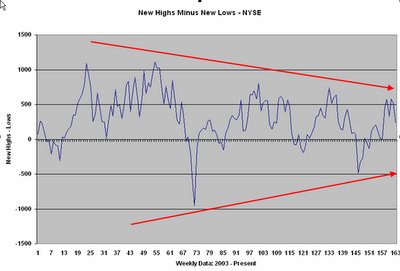To follow up on the Speculative and Non-Speculative stock research from my last posting, I decided to look at up days in the S&P 500 (SPY) and whether the relative performance of the Spec and Non-Spec stocks (many of which are not stocks in the S&P large cap universe) made a difference in future performance.
Since April, 2003 (N = 715), we had 69 days in which SPY was up by 1% or greater. Overall, the market was up by an average of .21% three days later (46 up, 23 down), a bit better than the average three-day gain of .16% (423 up, 292 down) for the sample overall.
I then broke the strong SPY days in half based upon the relative strength of the Spec stocks vs. the Non-Spec issues. (See yesterday's blog entry for a description of these stocks). To my surprise--and contrary to my initial hypothesis--when the Spec stocks were relatively strong, the next three days in SPY averaged a gain of only .05% (23 up, 12 down). When the Non-Spec stocks were relatively strong, the next three days in SPY averaged a gain of .36% (23 up, 11 down).
This suggests that strength in SPY is more likely to continue in the near term if Non-Speculative stocks (some of which are highly weighted in the S&P) are strong relative to Speculative issues.
When I examined weak S&P days--those down by 1% or more (N = 67) in the same sample--another interesting pattern emerged. Overall, when the market is down by over 1%, the next two days in SPY average a gain of .26% (34 up, 33 down). This is modestly better than the average two-day gain for the entire sample of .11% (392 up, 323 down).
When we divide the weak SPY days in half based on the relative strength of the Spec stocks, the results are eye-opening. When the Spec stocks are relatively strong during a weak day in SPY (N = 33), the next two days in SPY average a gain of .60% (20 up, 13 down). When the Spec stocks are relatively weak during a weak day in SPY (N = 34), the next two days in SPY average a loss of -.06% (14 up, 20 down).
This is quite a difference. It suggests that the S&P is more likely to rebound from weakness in the near term if Spec stocks are displaying relative strength. If Non-Spec stocks are relatively stronger, the weakness in SPY is more likely to continue in the short run.
In sum, a strong day in SPY is more likely to continue its rise if Non-Spec stocks are relatively strong. A weak day in SPY is more likely to reverse if Spec stocks are relatively strong. The latter effect appears stronger than the former.
I have much more exploration to do with this measure. The relationship between the relative performance of Spec and Non-Spec stocks and future market performance appears to be more complex than I initially envisioned. There are meaningful relationships here, and the key will be to identify and explain them. I will post more on this topic on my
Trader Performance blog tonight.






